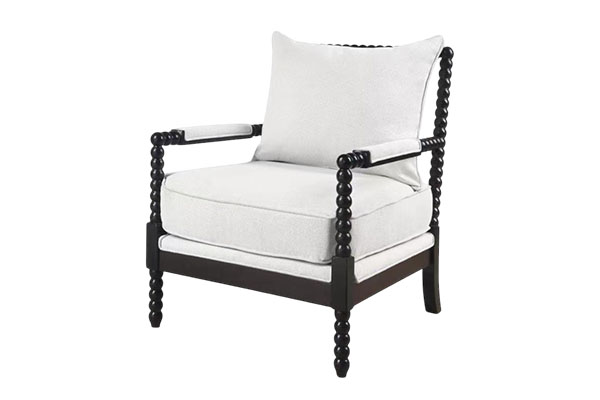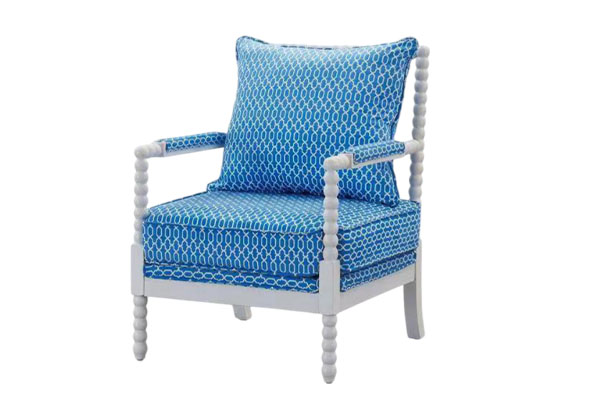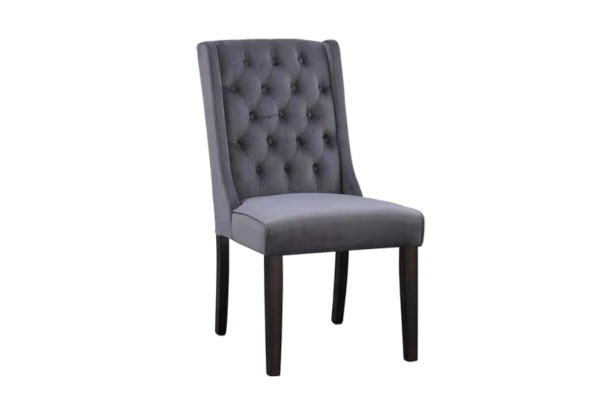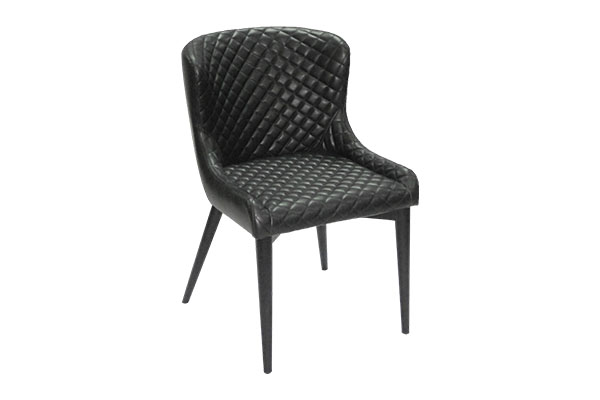How does the elasticity of rubberwood affect the long-term user experience of a dining chair?
Release Time : 2025-08-13
In furniture manufacturing, the choice of material directly impacts the performance and user experience of the final product. Rubberwood, due to its unique physical properties, particularly its elasticity, offers significant advantages in dining chair construction.
1. Comfort and Ergonomics
Rubberwood's elasticity makes it an ideal material for ergonomically designed dining chairs. This wood provides just the right amount of rebound when seated, alleviating discomfort from prolonged sitting. Compared to harder woods, rubberwood chairs better conform to the body's curves, distributing pressure points and reducing fatigue and discomfort caused by localized pressure. This comfort is particularly important for those who spend extended periods working or dining at the table. Furthermore, rubberwood's elasticity means it adapts to varying weights and postures, providing personalized support for each user. Lightweight and heavyweight users alike can enjoy a consistent and comfortable seating experience. This not only increases user satisfaction but also extends their time in the chair, fostering a more enjoyable family dining or work environment.
2. Shock Absorption and Noise Control
The elastic properties of rubberwood give this dining chair excellent shock absorption. When a user stands up or sits down, the rubberwood absorbs some of the impact, reducing the direct impact on the floor and protecting it from damage. This is particularly important for homes with wooden floors or other sensitive flooring, effectively preventing scratches and dents. This shock absorption also helps reduce noise levels during daily use. Traditional dining chairs made of hardwood often produce harsh sounds when moved or adjusted, but rubberwood's elasticity dampens these sounds, creating a quieter and more harmonious dining atmosphere. This is undoubtedly a significant advantage for consumers who pursue a high-quality lifestyle.
3. Durability and Fatigue Resistance
Although rubberwood has a certain degree of softness and elasticity, this does not mean it lacks strength. On the contrary, its elastic properties make rubberwood dining chairs more resilient when subjected to repeated pressure and stress. Resilient materials can "remember" and return to their original shape to a certain extent. This means that even after years of frequent use, a rubberwood dining chair will maintain its shape and function, resisting deformation or collapse. This self-healing ability helps extend the longevity of the dining chair. Compared to some traditional woods that age and crack easily, rubberwood dining chairs are more durable and can withstand the test of time. For consumers who prioritize return on investment, choosing a rubberwood dining chair means less frequent replacements and a better value for money.
4. Easy Maintenance and Low Maintenance Cost
Rubberwood's elastic properties also make it easy to maintain. Due to its flexibility, it is less susceptible to scratches or damage during daily cleaning and maintenance. Simply wipe with a damp cloth to remove surface stains without worrying about permanent marks. In contrast, some harder woods may require special care to maintain their appearance. Furthermore, rubberwood's natural luster and grain maintain their beauty without excessive artificial modification. Over time, proper care can impart a unique, rustic and elegant charm to a rubberwood dining chair, adding a touch of cultural flair to your home. This low-cost, high-efficiency maintenance method is ideal for busy modern families.
5. Environmental Protection and Sustainable Development
While this article does not discuss the fundamental properties of rubberwood, it is worth mentioning that its elasticity indirectly supports its application value as an environmentally friendly material. Rubberwood comes from natural rubber trees, which are harvested and reused after they stop producing rubber. This process not only reduces resource waste but also promotes the recycling of forest resources. This process embodies the effective management of natural resources and the concept of sustainable development, meeting the needs of contemporary consumers for green consumption.
In summary, the elasticity of rubberwood plays a significant role in enhancing the long-term use experience of dining chairs. From enhanced comfort and improved acoustics to increased durability and simplified maintenance, rubberwood's unique advantages have made it a preferred material for many homes and commercial spaces.
1. Comfort and Ergonomics
Rubberwood's elasticity makes it an ideal material for ergonomically designed dining chairs. This wood provides just the right amount of rebound when seated, alleviating discomfort from prolonged sitting. Compared to harder woods, rubberwood chairs better conform to the body's curves, distributing pressure points and reducing fatigue and discomfort caused by localized pressure. This comfort is particularly important for those who spend extended periods working or dining at the table. Furthermore, rubberwood's elasticity means it adapts to varying weights and postures, providing personalized support for each user. Lightweight and heavyweight users alike can enjoy a consistent and comfortable seating experience. This not only increases user satisfaction but also extends their time in the chair, fostering a more enjoyable family dining or work environment.
2. Shock Absorption and Noise Control
The elastic properties of rubberwood give this dining chair excellent shock absorption. When a user stands up or sits down, the rubberwood absorbs some of the impact, reducing the direct impact on the floor and protecting it from damage. This is particularly important for homes with wooden floors or other sensitive flooring, effectively preventing scratches and dents. This shock absorption also helps reduce noise levels during daily use. Traditional dining chairs made of hardwood often produce harsh sounds when moved or adjusted, but rubberwood's elasticity dampens these sounds, creating a quieter and more harmonious dining atmosphere. This is undoubtedly a significant advantage for consumers who pursue a high-quality lifestyle.
3. Durability and Fatigue Resistance
Although rubberwood has a certain degree of softness and elasticity, this does not mean it lacks strength. On the contrary, its elastic properties make rubberwood dining chairs more resilient when subjected to repeated pressure and stress. Resilient materials can "remember" and return to their original shape to a certain extent. This means that even after years of frequent use, a rubberwood dining chair will maintain its shape and function, resisting deformation or collapse. This self-healing ability helps extend the longevity of the dining chair. Compared to some traditional woods that age and crack easily, rubberwood dining chairs are more durable and can withstand the test of time. For consumers who prioritize return on investment, choosing a rubberwood dining chair means less frequent replacements and a better value for money.
4. Easy Maintenance and Low Maintenance Cost
Rubberwood's elastic properties also make it easy to maintain. Due to its flexibility, it is less susceptible to scratches or damage during daily cleaning and maintenance. Simply wipe with a damp cloth to remove surface stains without worrying about permanent marks. In contrast, some harder woods may require special care to maintain their appearance. Furthermore, rubberwood's natural luster and grain maintain their beauty without excessive artificial modification. Over time, proper care can impart a unique, rustic and elegant charm to a rubberwood dining chair, adding a touch of cultural flair to your home. This low-cost, high-efficiency maintenance method is ideal for busy modern families.
5. Environmental Protection and Sustainable Development
While this article does not discuss the fundamental properties of rubberwood, it is worth mentioning that its elasticity indirectly supports its application value as an environmentally friendly material. Rubberwood comes from natural rubber trees, which are harvested and reused after they stop producing rubber. This process not only reduces resource waste but also promotes the recycling of forest resources. This process embodies the effective management of natural resources and the concept of sustainable development, meeting the needs of contemporary consumers for green consumption.
In summary, the elasticity of rubberwood plays a significant role in enhancing the long-term use experience of dining chairs. From enhanced comfort and improved acoustics to increased durability and simplified maintenance, rubberwood's unique advantages have made it a preferred material for many homes and commercial spaces.







